![]()
Just after 10am on the morning of Tuesday, 9th June 1896, a young boy burst into the workshop of John Coates and his son Thomas, which was situated along the cobbled road of Bridge-street, Accrington and just behind the now forgotten, Brown Cow public inn.
In a frenzied state of mind, the boy shouted, ‘Oh, Mrs. Coates is murdered!’
Not sure what was happening, Mr. Coates replied back, ‘Nothing of the sort.’
However, the young boy raised one of his arms and to the horror of Mr. Coates, what looked like fresh splatters of blood splatters could be seen.
Alarmed, Mr. Coates and his son, Thomas, left his workshop and made their way back to their home which was only a few minutes away on nearby Warner Street.
Upon their arrival, Mr. Coates quickly made his way upstairs and to his horror, his wife, Sarah, although alive, looked to be in a very distressing state and lying on the bedroom floor, only yards from the door. Upon closer inspection, it was clear she had suffered from a serious attack, with blood flowing freely from an open wound on her throat. She tried desperately to speak, but the injuries to her throat were so severe, she could only utter a few groans.
Thomas, who had followed his father upstairs and upon seeing his mother in such a pitiful state, rushed downstairs to a neighbour named Mrs. Bradley, who in turn sent for Dr. Monaghan.
Meanwhile, the boy who had alerted Mr. Coates and his son, Thomas, to the attack on Sarah, had himself set off to find a doctor, and in no time at all, he had arrived at the surgery of Dr. Clayton.
“There’s been a murder in Warner-street,” he would scream upon entering the surgery.
As particulars of the affair began to leak out, the identity of the perpetrator remained absolutely unknown, but it would soon transpire that a boy named Christopher Hindle who was just 15 years of age and a carpenters apprentice for both Mr. and Mrs. Coates, would soon become the center of attention – and it was this very same young boy who had raised the alarm at Mr. Coates workshop only half-an-hour so earlier!
At around 10:25am, P.C. Andrews, who was on duty that morning, had been standing close to the Commercial Hotel at the end of Church-street when a man named Benjamin Simpson rushed past him. Upon nearing the constable, Simpson shouted, ‘There’s been some throat-cutting up here at the top end of Warner-street!”
P.C. Andrews quickly made his way into Warner-street, and upon arriving at No.3 and the home of John Coates and his wife, Sarah, he found the area buzzing in a state of disorder as a small crowd had congregated outside.
Inside the house, P.C. Andrews saw John Coates and his son, several neighbours and Christopher Hindle.
The scenes inside the house had become hectic, with people screaming and not knowing what to do. P. C. Andrews went upstairs, and in the back bedroom discovered Sarah Coates lying on her back in a pool of blood. She was barely alive and bleeding profusely from a wound in her neck. There also appeared to be marks of strangulation over her throat.
Hindle, who had lived with his parents and brothers and sister at No.2, Chapel-street, was also bleeding from several slight cuts on one of his arms and after receiving help from P.C. Andrews and after having his wounds bandaged, the officer accompanied him to the police station to take his statement and to what had transpired that morning.
For context, No. 3 Warner Street was not just a home for 51 year old, John Coates and his wife, 61 year old, Sarah, it was also a shop from where they would make cabinets. Behind their shop, and adjoining the back bedroom, was a small workshop which could only be accessed from upstairs.
At the police station, Hindle would begin to tell the story of how he had seen a man standing over Sarah Coates in the back bedroom, and it was only when he was startled by Hindle’s appearance, the man threw down the knife and escaped through a window and down the back street.
According to a description of the man made by Hindle, he had appeared to be 28 or 30 years of age, and around 5ft 8ins in height. He had a dark complexion, black moustache, and was very smart in general appearance, with a low fashionably cut waistcoat and blue tie.
The description of the man was quickly sent to all neighbouring towns, with Inspector Sinclair making telephone calls, asking that all police officers to be vigilant, especially where all of the entrances and exits to and from the town were situated.
As for the murder weapon used during the attack on Sarah Coates, the knife was taken and looked after by P.S. Bale, who along with P. C. Cameron and P.C. Andrews, where all engaged in the case.
It was a pocket knife of the average size, but what marked it out amongst other types of pocket knives was the method of opening it. When shut it is secured at the one end by a clasp. On this being undone, the metal handle is divided right down the centre, and opens on each side, the two parts being brought right round until they meet again, and form a handle to the very sharp one-edged blade they previously concealed.
In this position, the handle is secured by a clasp, rendering it as difficult to close as it was to open it.
The knife was also the property of the son of John and Sarah, Thomas, who had apparently left it on a window sill in his own bedroom on the morning of the attack. This being the case, it would therefore appear that the murderer had to go to the front bedroom to take the pocket knife before returning to the back bedroom and to where the attack on Sarah took place.
Exhaustive enquiries by the police would soon lead them to suspect that Christopher Hindle, upon which many of the aspects of the crime had been relayed to them by Hindle himself, may not have been telling the truth. After speaking to several witnesses, including two workmen who had been in the back yard of Warner-street on the morning of the murder who would testify that no person ever ran down the back, Hindle was taken to the police station where he would be detained pending further questioning.
It was whilst being detained, Dr. Geddie and Dr. Monaghan both examined Hindle’s arm. They would see that he had around 18 scratches on the right arm, but only two of them would be described as ‘wounds’. They would also form the opinion that these scratches could easily have been self-inflicted.
The police were by now treating Hindle’s statements with considerable suspicion, looking into several instances that seem to contradict what Hindle had told them. From the two men working in the backyard on the morning of the murder to at least three different statements made by Hindle and how he had chased after the man after fleeing from No.3 Warner-street. Statements made by Hindle that had said he had ran after the man down the back street and up into Abbey Street to another statement this time saying Hindle had chased after the man towards Oak-Street, and then finally a third statement saying he had jumped over a gate and into Back Warner-street.
Something wasn’t adding up and with each examination of the property and the conflicting stories Hindle was making, the police would eventually charge Hindle with the murder of Sarah Coates.
At a quarter past two on Wednesday, 10th June – the inquiry into the death of Sarah Coates began. The coroner, Mr. H. J. Robinson took his seat at the Accrington Borough Police Court.
The Coroner in his opening remarks told the jury that this was a serious enquiry and it would be for the jury to say whether they were satisfied as to the woman having taken her own life, and, if they did not arrive at that conclusion, who was responsible for her death.
A timeline of events would be given, and it appeared that Sarah Coates was ironing in the house, with Christopher Hindle, who was employed in the shop, dusting and cleaning in the workshop. They appeared to be the only two people in the house at the time.
On being given detailed information on the layout of the house, with many rooms being up and down stairs, the jury were advised that before they took any evidence from the witnesses, they ought to go and inspect the scene of the tragedy. After a short deliberation, in company with the Coroner and Inspector Sinclair, the jury accordingly retired and made their way to the property.
They would return shortly after, and this time, many people had arrived at the court, all eager to hear the latest developments in the case and it would be John Coates who would be first to be questioned.
He would tell the jury that Hindle had been his apprentice for six months and that he had sent him to his shop on Warner Street to do a little cleaning and dusting two or three times a week. He would also tell them of the moment when Hindle had rushed into his shop on Bridge-street, informing him that Mrs. Coates had been murdered.
John would also mention that money had gone missing from a drawer in the front sitting room on several occasions; with the latest time this happened only the day before, on the 8th June.
Interestingly, John would also mention that there had been some unpleasantness between his wife and that of Hindle, and on one occasion she had complained of his conduct.
Thomas Coates was next to be questioned and he too would back up his father’s claims of money going missing, saying that he missed 5 shilling from a drawer in this bedroom the week before Whitsuntide. He had also placed 7 shilling in the drawer on Saturday and another shilling in the drawer on the Sunday prior to the attack on Sarah Coates. The shilling, however, was not there on the Tuesday morning and the same day Sarah was attacked.
P.C. Andrews, when giving evidence, stated that he had asked Hindle how the events unfolded, with Hindle replying; “I was dusting the front shop, and hearing a noise, went upstairs, and found Mrs. Coates lying upon her back in the back bedroom, with a strange man standing over her trying to strike her. When he saw me he made a cut at my throat, and then got up and tried to strike me with a knife. I got hold of the man’s coat tails, and he then struck me several times about the arms until I was obliged to let go of him.
“He ran through the door, down into the backyard, jumped over the gate, and got into Back Warner-street, and up into Abbey Street, near to the Wesleyan Chapel.”
Andrews continued with his evidence, and disclosed that on the top of the wall, by which, according to Hindle, the murderer escaped, there were a number of iron spikes.
He would also tell the jury that at the time Hindle was making his statement, he noticed Hindle’s right arm and hands were covered with blood. He had, in all, about a dozen wounds of one sort or another, most of them being like pin scratches, but appearing to have been inflicted with a knife.
Police Sergeant Robert Bale deposed that at the time of the murder, he was at the junction of Blackburn-road and Peel-street. Hindle came to him and shouted, “Two of you are wanted at Mrs. Coates.”
Upon making his way to the scene, P.S. Bale would tell the jury that Mrs. Coates was lying on her back in a pool of blood. Her false teeth had fallen out of her mouth into the blood, together with threepence in copper, while a scarf she had been wearing was saturated in blood.
Mrs. Coates was alive when he arrived, but died eight minutes afterwards. He had asked Mrs. Coates several times as to who her attacker was, but she kept repeating, “Oh, turn me over on my side.”
Having heard Hindle’s statement and how a man had escaped by the back stairs, he proceeded to inspect the area, soon discovering spots of blood along the entry, extending within a few yards from the back-door.
Hindle had also informed P.S. Bale that two men had been working outside the back, who saw the man, but although he had shouted, ‘Murder! Stop that man,’ they took no notice.
After speaking to several neighbours from Warner-street and people who had been working alongside Bridge-street on the morning of the attack, the jury adjourned at around 5.45pm for luncheon for half-an-hour.
Upon their return, Inspector Sinclair was the first witness to be called and after describing what he had witnessed at No. 3 Warner-street, he stated that he asked Hindle to describe the man who had committed the murder. Hindle replied, “He is a man about 28 or 30 years of age, 5ft. 8In. high, dark complexion, black moustache, dressed in a navy blue suit with low waistcoat, turned down collar all round, blue tie, and dark brown cap. I can tell him again if I see him, and I’ll go to the railway station to look out for him.”
Inspector Sinclair then told of how he sent Hindle, along with P.C. Andrews to the railway station, whilst he himsef hurried to the police station, and telephoned the description of the attacker to all neighbouring forces. He would also arrange for plain clothed police officers to patrol the various districts and to keep a sharp lookout.
Shortly later, Hindle and P.C. Andrews returned to Warner-street where Inspector Sinclair and Dr. Monaghan where inspecting the scene of the murder.
Hindle would tell Inspector Sinclair how the events unfolded and how the man in the blue suit had escaped from the building. Hindle told of how, after a short struggle, he chased after the man into Oak-street, but the man was too quick and managed to get away.
Hindle was then asked by the Inspector to go at once to the police station, and as he was doing so, Inspector Sinclair examined the door which Hindle said he had climbed, but he found no marks of any kind there.
He would, however, find blood stains leading from the bottom of the stairs to the front door of the shop. These blood stains also appeared to head towards the back door.
In total, sixteen witnesses were examined, and the inquiry would last for just over seven hours.
Evidence would also suggest that small sums of money had been missing from the premises on more than one occasion. Information given would also say that Hindle had lied about the events that took place on the 9th June in that he did not leave the premises by the way he had stated.
After one hour of deliberations, the jury returned a verdict to the effect that Mrs. Coates had been wilfully murdered, and that there was prima facia evidence against Christopher Hindle.
After expressing deep sympathy with Mr. John Coates and his family in the sad bereavement, the Coroner entered a verdict of wilful murder, and Hindle was committed for trial at the Lancaster Assizes.
On hearing the charge put before him, Hindle appeared unmoved, and as he was being escorted from the court, he shook hands with his father before disappearing to the underground passage and into the waiting cells below.
The following morning, 11th June, and at ten o’clock, Hindle was brought before the Accrington magistrates and charged with the wilful murder of Sarah Coates. A large crowd had assembled outside the Town Hall, and upon the court doors being opened, it only took a matter of minutes before the court itself was full.
As Hindle made his way into court, his demeanor was very similar to that he showed during the inquest the previous day, appearing very little concerned at the situation he was in.
After hearing a brief outline of the murder and the evidence showing Hindle had made false statements, he would be remanded until Friday, 12th June at ten o’clock.
No further evidence was offered when Hindle was brought back into court the next day and he would be remanded for another week. During this time, Hindle would spend the next seven days incarcerated in the prison at Preston.
The funeral of Sarah took place on Friday, 12th June 1896 and her body was interred within the grounds of Accrington Cemetery. A considerably large crowd ascended all along Warner-street, mainly consisting of women and children. Blinds were drawn by the neighbours as well as those living in houses that followed the route from No.3 Warner-street and all along Burnley Road and towards the cemetery.
Her coffin bore the inscription; “Sarah Coates, died June 9th, 1896, aged 61 years.”
Wreaths had been sent by Alderman Smith of Springhill; Mrs. Bunting of Quarry Hill and by the Wesleyan Society Class, of which Sarah had been actively involved.
A short service took place within her home before her coffin was placed inside a hearse.
On Wednesday, July, 8th 1896 – the trial of Christopher Hindle, on the charge of murdering Sarah Coates would begin at the Lancaster Assizes with Mr. Justice Cave, presiding over the case.
The trial would only last one day, with Mr. C. P. M’Keand and Mr. Ambrose Jones prosecuting and it was M’Keand who would open proceedings with a long and thoroughly detailed explanation of what had taken place back on the 9th June.
Many witnesses came forwards, mainly the same ones who took to the stand during the initial inquests shortly after the murder .
However, it was Hindle’s defense attorney, Mr. Shee, who would put the onus on the jury, by admitting to them that Christopher Hindle may have told a lie, BUT, boy’s did tell lies and it was one thing to PROVE that he had told a lie, and another thing to prove that he had committed a murder.
He would tell the jury that whilst M’Keand had tried to prove that a strange man had NOT escaped from the house by climbing over the back-yard door, whilst being persued by the boy, was it more likely that that a murderer would rush out into the street?
“It certainly would seem that is the case.” Mr. Shee would say.
Mr. Shee would also bring up the moment when Sarah Coates, whilst dying, was asked who had attacked her.
“When asked who had done it, the murdered woman said, ‘nobody’.” Mr. Shee told the jury.
“Had the prisoner been guilty, would it not have been as easy for her to say, ‘Christopher,’ his Christian name?” he would continue.
The prosecutions case, it appears, was resting on the evidence submitted by Inspector Sinclair and the blood stains he had found on the morning of the murder. M’Keand would argue that, as none could be found anywhere in the back yard of Warner Street, Hindle had simply concocted a tale of a man in a blue suit to try and put the police off track. Mr. M’Keand would also argue that as the two laborours whom had been working close to the back yard off Warner Street had not heard any shouting or commotion coming from No.3 Warner Street, and that they had never seen anyone loitering in the area before or after the crime had been commited, then it was just another tale that Hindle had made up.
And as for the question of motive, M’Keand would mention how money had gone missing on several occasions, often being taken from Thomas Coates bedroom.
As for the wounds found on Hindle’s arm, the prosecution would also tell the jury that these could have been self-inflicted as stated by both Dr. Geddie and Dr. Monaghan.
The jury retired just after 5pm but would only be gone for around twelve minutes. On their return into court, a verdict of guilty, but added a strong recommendation of mercy on Hindle.
When asked why sentence of death should not be passed upon him, Hindle made no reply. So it left the Mr. Justice Cave with nothing else to say except for passing down the sentence of death in the usual form.
Donning the black cap, he said: “You have been found guilty on very clear evidence of the murder of this poor woman. The jury have added to their verdict a recommendation of mercy, which I will take care shall be forwarded to the proper quarter. I do not hold out any hopes as following from such recommendation. It will have due weight and more than that I cannot say. It is my duty to pass upon you the sentence of the law.”
Almost as soon as the death sentence was passed, efforts began in ernest in the hope of securing the commution of his sentence, and whilst the judge may not have held much hope of Hindle being reprieved from the gallows, the feeling outside the courts was nevertheless much more optimistic.
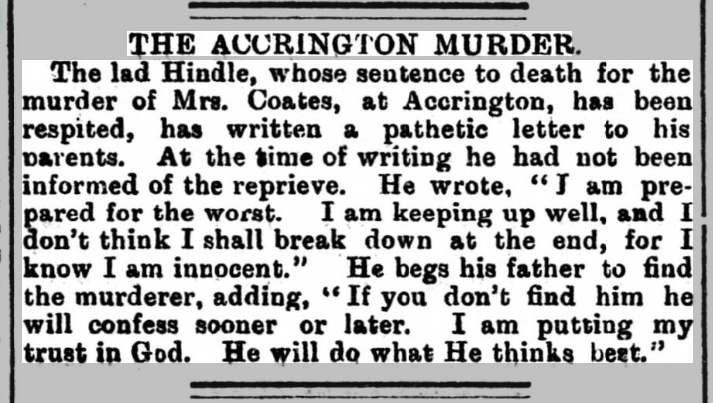
On Saturday, 11th July, a petition to secure a reprieve was drawn up by solicitor, Mr. Whithers.
It stated that the petitioners were “fully cognisant of the serious nature of the crime for which the prisoner has been found guilty. That though the carrying out of the capital sentence may act as a deterrent to evildoers and as a punishment of an awful character, yet we pray that under the peculiar circumstances of this case a commutation of this most severe sentence of the law may be made. That it is revolting to the feelings of all intelligent people that a boy of the tender years of the prisoner should be called upon to undergo death, and there are also circumstances about the boy’s disposition which compel us to think that the reduction of the present sentence is desirable in the interests of humanity.”
The petition was signed by many hundreds of people from Accrington as well as influential business men and religious ministers. A collection was also made to help cover the costs of the trial the parents of Hindle were very poor.
With youth on his side, many thought this would be enough to save him.
They would be right! And on Wednesday, 15th July, a telegram received at Accrington from Sir Joseph Leese, M.P., announced the decision of the Home Secretary to respite the death sentenced handed down to Hindle.
But before the news was communited to him, Hindle had written a letter to his parents on the 14th July;
“Dear Father and Mother, Sister and Brothers, – I was very glad to have a letter from you, and that you are all well at present, and I write to tell you that I shall be glad to see you in a week or so, for I have got permission to see you when you can come, and I can tell you that it is fixed for the 28th of this month, but I cannot say that it will come off or not, as I am preparing for the worst, so I shall not be surprised if the worst happens, and I hope you are prepared for the worst as well, so you will not be dropped on if it does happen, and I am keeping up well and do not think I shall break down at the end. I know I am innocent of it, and I hope it will come out. I wish you to find the man, and then I shall be out of trouble, and then they would know I have not done it. I am glad to think you are doing all you can for me as well as all my friends. I have a good many of both. I am very sorry to think that Uncle Ben broke down last Wednesday, and I am very glad to think that all the others are keeping up well, for I am sure I could not help bringing all this trouble upon you, as I have done my best as well as you. I eat and sleep well, and keep thinking out of my head by reading books out of the library. I am very glad to thnk that my mate, Will Baron, is thinking of me, as I thought they would have foresaken me in this thing. I know it is a disgrace to all the family as well as to me. I would not care so much if there had been only me to bear it. I know it is as hard for you as for me, but I am putting trust in God to help me in this trouble, and He will do what He thinks right. When we have done meeting in this world I hope we shall meet in the other world above, for He knows who has done it. And as the innocent have to suffer a long time sometimes before they are released, I hope you will keep a sharp lookout for the man who has done it, and if you do not find him he will confess sooner or later. I pray to God to help me. So no more at present. I now close my letter. From you affectionate, and loving son and brother. C. HINDLE.”
It was during Hindle’s incarceration in Manchester prison that something intriguing came to light, and that was an alleged confession from a man who had admitted to killing Sarah Coates.
On the 28th July, 1896, the mangled remains of a body were discovered on the Lancashire and Yorkshire Railway line near Bent Bridge, Leyland. Upon investigation, several items of interest came to light that, in some respects, maybe should have been taken more seriously.
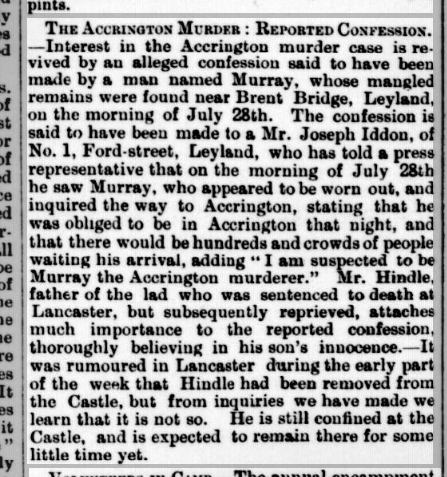
Firstly, the body of the man was that of John William Murray. Secondly, he was aged between 28 and 30 years old and of medium build and with a moustache. But perhaps more tellingly, he was wearing a blue suit.
And if we are to add more fuel to the fire, he was a hairdresser and assistant to a Mr. Liptrot on Abbey-street, Accrington – extremely close to where the events of June 9th had taken place.
Murray also lived in Briggs-yard, only a short walk away from Abbey Street and surrounding streets such as Oak, Bridge and Warner-street.
Before taking his own life, Murray had spoken to a man called Joseph Iddon, of No. 1 Ford-street, Leyland.
Iddon later spoke to a press representative, saying that on the morning of July 26th he saw Murray, who appeared to be worn out, and who inquired as to the way to Accrington. Interestingly, Murray had told Iddon that there would be hundreds and crowds of people waiting his arrival, adding, “I am suspected to be Murray the Accrington murderer!”
“What,” asked Iddon, “belonging to Hindle’s affair?”
Murray then paused before replying, “No; belonging to a mother and two children who were murdered. I must be in Accrington to show myself up.”
The importance of this confession could not be underestimated and Thomas Hindle, Christopher’s father, had had thoroughly believed in his son’s innocence, would plead with the authorites to look deeper into the movements of John William Murray on the morning of Sarah Coates murder. After all, pretty much everything Christopher Hindle had told the police matched up perfectly with the description of Murray. From his blue clothes he was wearing to the mans age.
However, and as strange as it seems, the police would not place any importance on the confession or in any of the bizarre circumstances surrounding the murder of Sarah and the man in the ‘blue suit’ as described by Hindle.
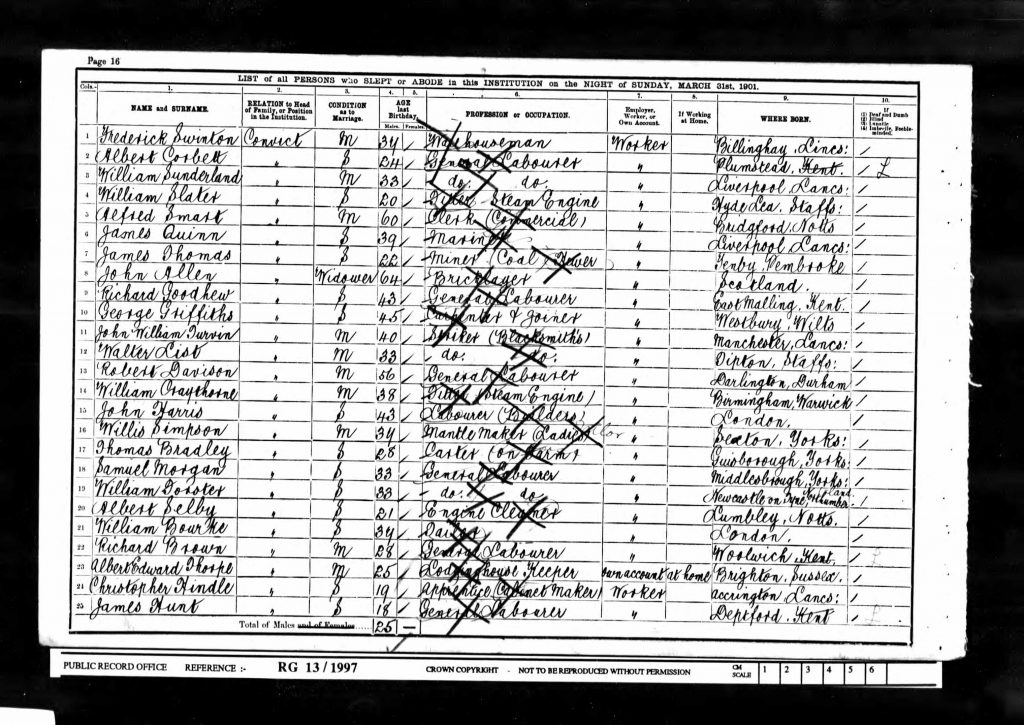
Christopher Hindle, even though a petition to spare his life was successful, would spend the next eleven years of his life in penal servitude within the confines of Manchester prison and towards the end of his sentence, Dorset prison. It was original stated that it would be at least twenty years before his release and that he would be around 35 years of age before he would be a free man, but all this was dependant on how he would conduct himself whilst in prision.
Therefore, to be released in 1907 and after serving just eleven years, it would seem to suggest that he had conducted himself in the right manner.
Hindle relocated to Liverpool shortly after his release from prison, and he would eventually emigrate to Quebec, Canada on the 9th July, 1910, travelling on the Megantic which was part of the White Star Dominion Line shipping company. He was 29 years old.
By 1915, Hindle had returned back to England and living in Coventry and in January that same year, he would marry Louisa Taylor. Together they would welcome two sons into their family – Thomas, who was born on the 18th December 1915 and Jack, who was born on the 4th February 1921.
The 1921 census records show that Christopher and his family relocated back to the North West, residing at number 534 Burnley Road, Waterfoot. Christopher was employed as an engineers pattern maker, working for Rossendale Engineers Coy. His wife, Louisa, was employed as a dress maker.
Interestingly, Mary Alice Hindle, sister of Christopher, was also living with the family and she was also working as a dress maker for Ma Huntle.
In 1939 they had moved again, this time to number 2, Parcy Terrace in Rawtenstall.
Christopher Hindle would live to the age of 76, when he would pass away in October 1957. He had outlived his wife, Louisa, by ten years, whom had passed away ten years previously, in December, 1947.

Final thoughts;
The murder of Sarah Coates to this day is as baffling now as it was back in 1896. Christopher Hindle always maintained he was innocent all throughout his arrest, trial and subsequent incarceration in prison. His description of the man responsible for the murder matched up very closely to that of John William Murray who committed suicide just one month after the barbaric attack on the 9th June at number 3 Warner Street.
But why didn’t the police take this seriously? It would transpire that Christopher possibly knew of John and this is quite likely, as both of them lived and worked within a few hundred metres of each other. With Christopher working on Warner-street and James over on nearby Abbey-street. No doubt these two individuals would have crossed paths on occasions and perhaps they did know each other in some capacity.
The police therefore summerised that if Christopher had known John, then why didn’t he name him as the man who had attacked Sarah that morning?
Whilst this case is tragic and nothing should be taken away from the fact that an innocent woman had lost her life in the most savage of ways, we should also remain open minded on who the real murderer was.
Was a 15 year old boy really capable of murder in such a barbaric manner? Had he been caught stealing money from the shop by Mrs. Coates? Had he panicked and tried to cover up his stealing by attacking Sarah? It seem’s such an extreme way to conceal one’s tracks!
But if he was telling the truth and that a man wearing a blue suit had sneaked his way into No.3 Warner-street before committing murder was factual, and the strange suicide of John William Murray and his confession before taking his life is anything to take seriously, then we should perhaps feel some sympathy for Christopher Hindle, who had to spend eleven years behind bars for a crime he ‘may not’ have committed.
Sources used in this story;
Blackburn Standard – Saturday 13 June 1896
Blackburn Standard – Saturday 20 June 1896
Derby Daily Telegraph – Thursday 16 July 1896
Lancaster Standard and County Advertiser – Friday 17 July 1896
Preston Herald – Saturday 18 July 1896
Illustrated Police News – Saturday 20 June 1896
+ many more courtesy of the British Newspaper Archive – www.britishnewspaperarchive.co.uk and www.ancestry.co.uk
Please follow me on social media;
Twitter – https://twitter.com/dohpods
Instagram – www.instagram.com/dohpods
Youtube – https://www.youtube.com/c/DaysofHorrorPodcast
Music;
Casual Desire – Ugonna Onyekwe – No Copyright Music
Contact – The Tower of Light – No Copyright Music – YouTube Audio Librar

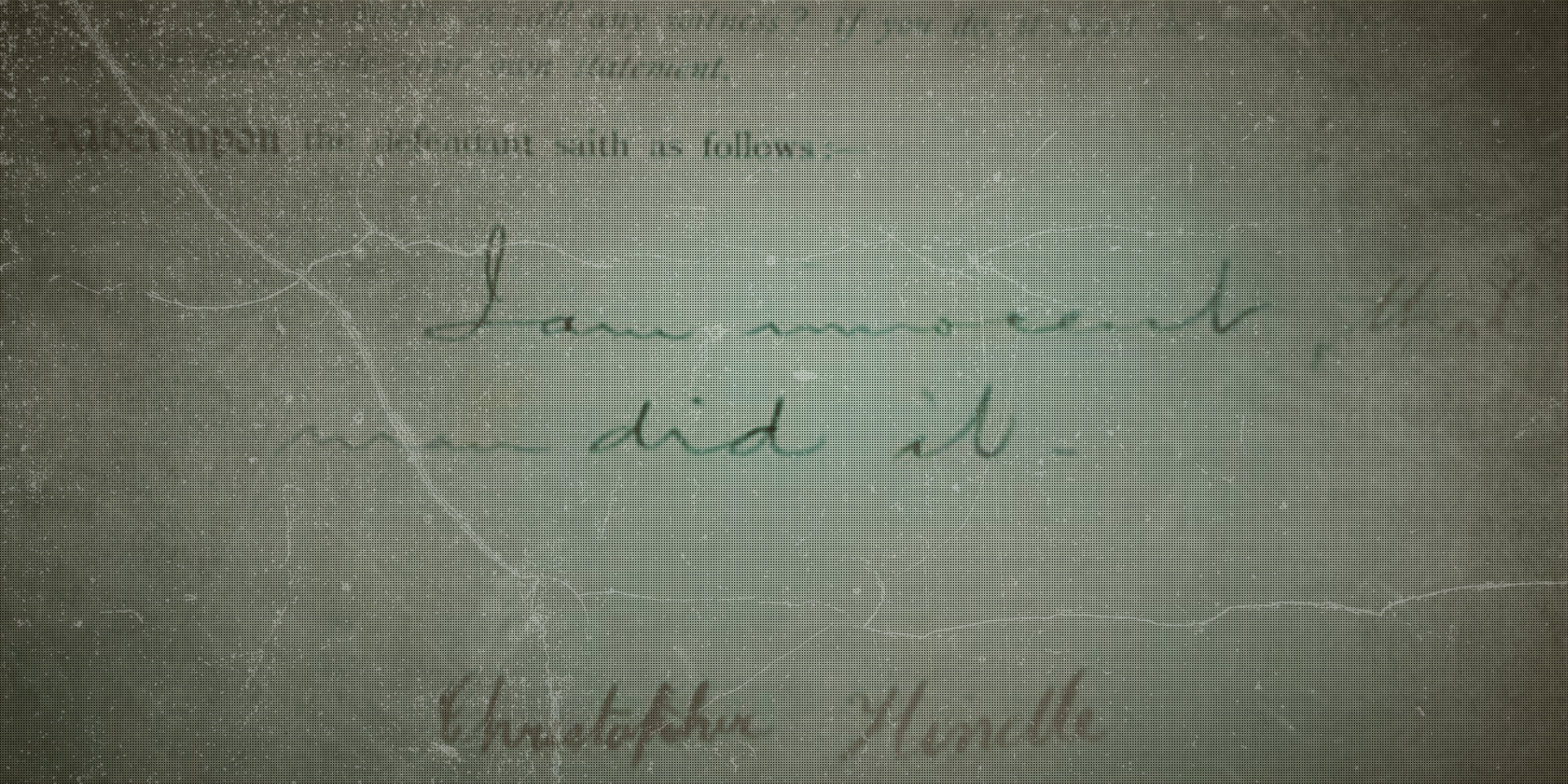
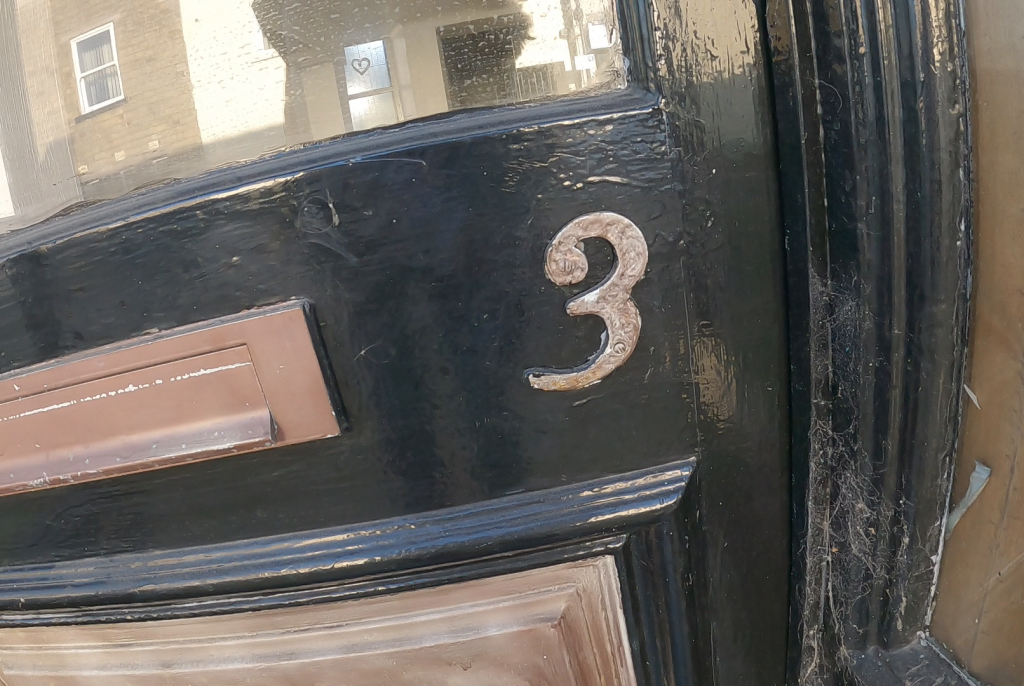
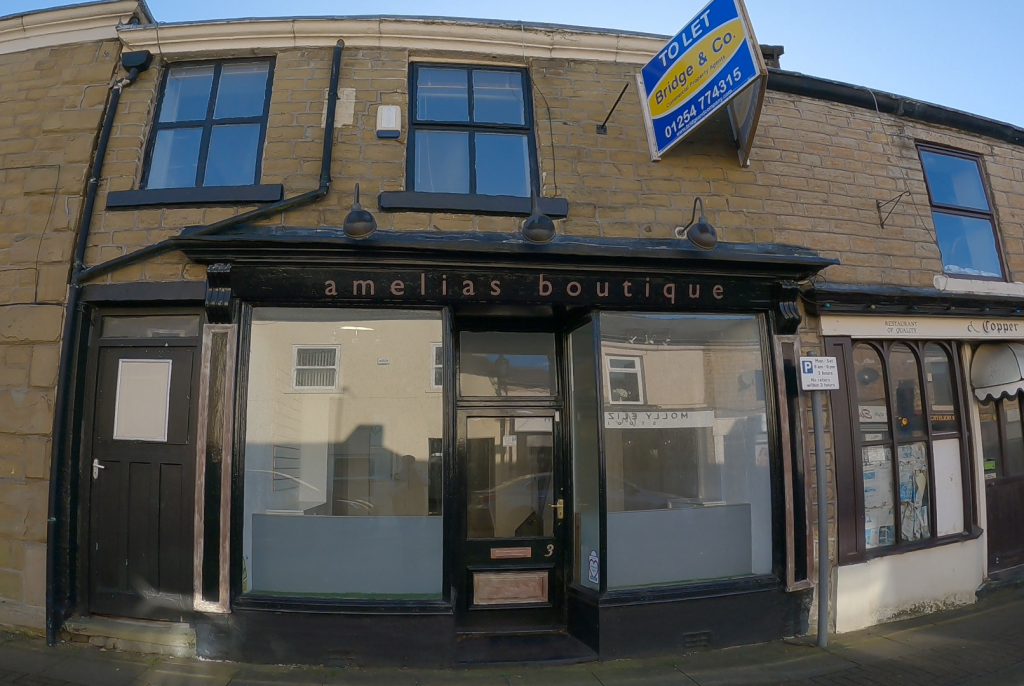
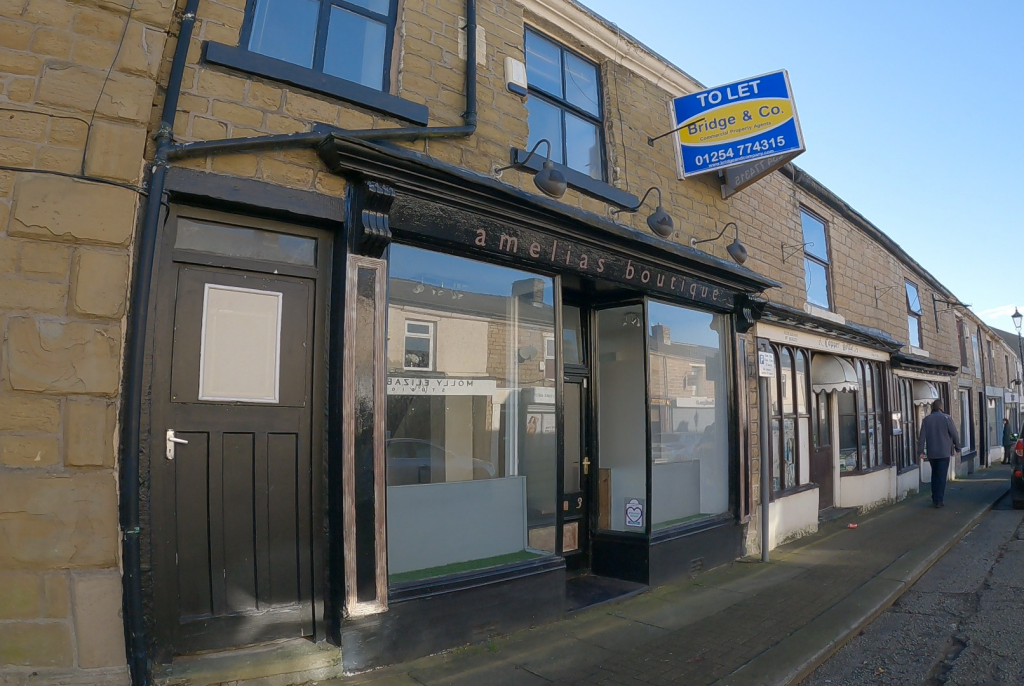
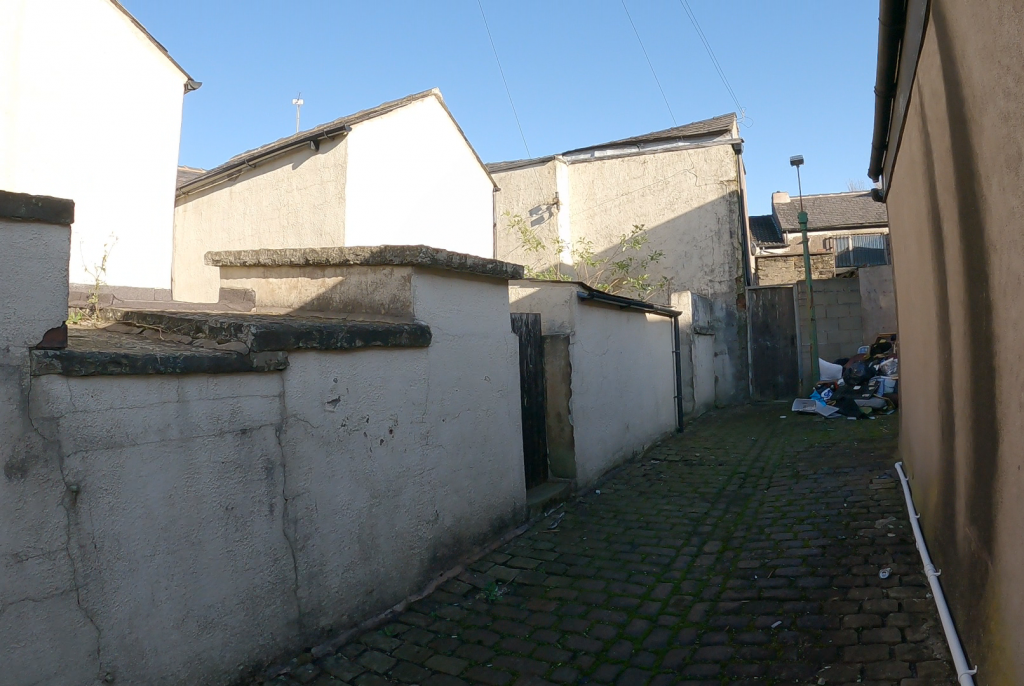
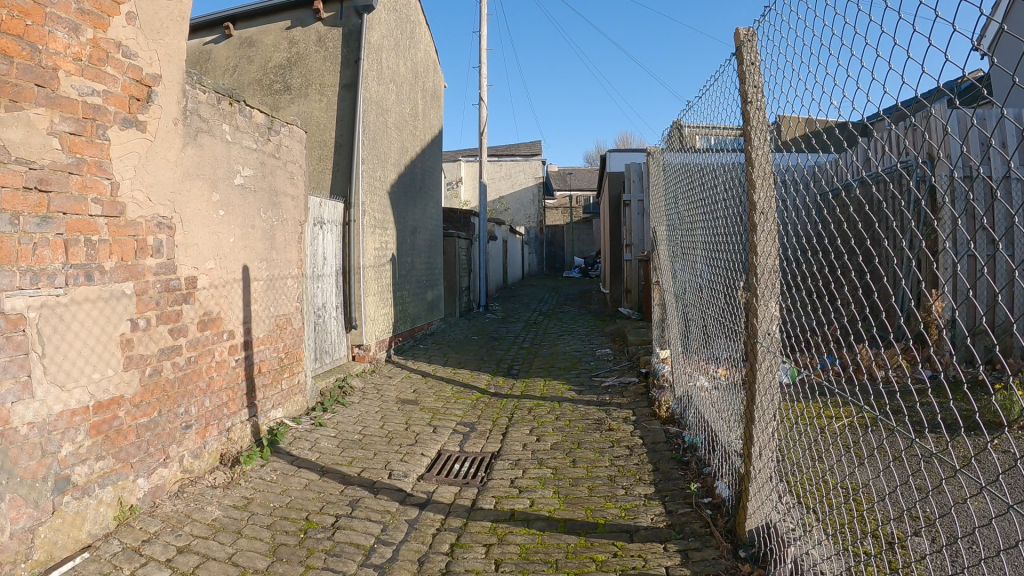
Leave a Reply